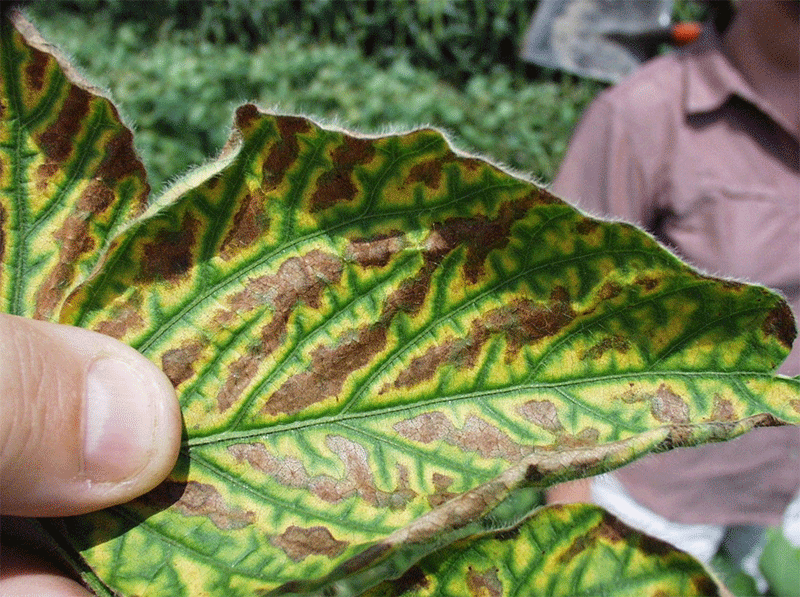An integrated approach
TIPS FOR MANAGEMENT OF SUDDEN DEATH SYNDROME
THE NAME SOUNDS serious, and it should — sudden death syndrome (SDS) of soybeans is a fungal disease that can have swift and serious consequences.
PHOTO: CLOSE UP OF SDS IN LEAF.

Since its appearance 40 years ago, it has spread to most of the soybean-growing area in the United States and Ontario, and continues to move into new areas. The most widely-used farm management strategy for lowering the risk of soybean SDS is to select plant varieties that have demonstrated resistance to the disease. But genetic resistance is not enough; farmers need additional strategies.
A three-year study on this topic wrapped up last fall, supported by the Grain Farmers of Ontario – Ontario Farm Innovation Program. This Ontario study is tied into a larger regional study involving researchers from Iowa State, Purdue, Michigan State, and University of Illinois.
In Iowa and the rest of the Midwest, SDS is emerging as the number two soybean disease after soybean cyst nematode (SCN) in terms of yield loss, says Daren Mueller, the principal investigator of the study and an assistant professor of plant pathology and microbiology at Iowa State. In Ontario, SDS continues to increase, especially in the southwest, and is often associated with SCN infestation.
EARLY PLANTING, SCN AND FUNGICIDES
The regional project objectives included
- Determining if earlier or later planting reduced the risk of SDS;
- Studying the relationship between soybean cyst nematode resistance and SDS resistance; and
- Assessing the effectiveness of new products, such as fungicide seed treatment.
This project continues SDS work that started over a decade ago in the U.S. Past research determined that the later the fungus infects seedlings, the more resistance the plants have to SDS, Mueller explains. In this recent study, that was confirmed.
Researchers found SDS incidence increases with earlier planting, and if planting occurred before May 15 in fields where SDS developed, there was a 5.5 bu/ac yield loss. These findings have shown wet, cool weather in the early spring is a major SDS risk factor.
“The early infection factor is also why we wanted to look at seed treatments,” Mueller says. “Bayer CropScience has a new one called ILeVO, which in this regional project was studied from 2013 to 2015.” Using seed treated with ILeVO averaged a yield boost of 3.4 bu/ac overall over the first two years, with a 5.7bu/ac increase when SDS severity was highest, and a 2.1 bu/ac increase even under low SDS severity. Other products were tested as well, but have not shown the same level of SDS control as ILeVO.
IN-FURROW TRIALS
It was also found that in-furrow fungicide treatments reduced SDS and increased yields compared to the untreated check. Foliar applications were less effective, but some treatments still resulted in increased yields. “The only fungicide that consistently worked as an in-furrow has the same active ingredient (fluopyram) that’s in ILeVO,” says Mueller. ILeVO has been available to U.S. growers since 2014 but unfortunately fluopyram as a seed treatment or in-furrow application has not received Pest Management Regulatory Agency registration in Canada (as of December, 2015).
This latest project also looked at the role SDS and SCN resistant varieties play in SDS management. Varieties with low to moderate resistance to SDS, as well as different SCN resistance genes (PI88788 and Peking) or no SCN resistance, were tested. There was a yield benefit by incorporating both SDS and SCN resistance in a variety, says Albert Tenuta, field crop pathologist with the Ontario Ministry of Agriculture, Food and Rural Affairs, especially in combination with the ILeVO SDS seed treatment. Tenuta says Ontario growers in areas with SDS are encouraged to plant a variety with both SDS and SCN resistance to minimize yield losses.
As a result of this project, SDS management guidelines have been updated and incorporated into two new Crop Protection Network Extension Publications: ‘Scouting For Sudden Death Syndrome’ and ‘Sudden Death Syndrome — Soybean Disease Management Series’ which are available at the Grain Farmers of Ontario Website (see sidebar).
This research project was funded in part by Grain Farmers of Ontario.
CROP PROTECTION NETWORK PUBLICATIONS UPDATE
Many publications are developed by the Crop Protection Network (CPN), a multi-state and international collaboration of extension specialists and other professionals that provides unbiased, research-based information.
There are two new SDS publications named ‘Scouting For Sudden Death Syndrome’ and ‘Sudden Death Syndrome – Soybean Disease Management’ for farmers and agronomists available online.
There are other CPN publications. These include a booklet on a new disease to Ontario called soybean vein necrosis virus. This publication describes the symptoms as well as how to scout and distinguish soybean vein necrosis virus from other plant problems. Other publications examine white mould, soybean seedling diseases, stem canker symptoms, and management.
There is also a new four-page scouting card called ‘Scouting for Common Soybean Seed Diseases’, containing images, symptoms, and general management strategies. To see all materials and download the ones you want, visit http://gfo.ca/Production/Production-Resources. •







